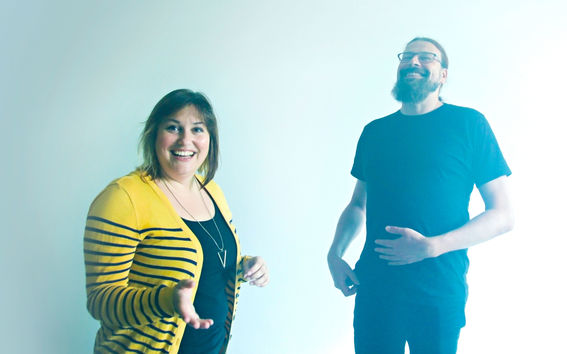One atom at a time

Every Monday morning at 9am, Milica Todorović grabs a bowl of porridge and sits down to talk with computer scientists about how machines learn.
Todorović is one of the many researchers from the natural sciences looking to apply the power of AI in her daily work; by keeping up with what experts in machine learning are doing, she hopes to bring some tiny things together in smarter ways.
What kinds of tiny things? Think minuscule.
Milica Todorović’s work focuses on how devices from mobile phones to solar panels function at the atomistic level, the smallest unit of ordinary matter. Her days revolve around finding the best composite materials to get the job done. With global challenges like adopting green energy, the world needs these kinds of advanced materials to bring about the next wave of technology and energy solutions.
“The forefront of materials engineering is really in making complex materials that combine vastly different properties,” explains Todorović.
In her case, this typically involves a mix of organics, generally soft materials like cellulose from wood products, and inorganics, like metals. With the seemingly never-ending list of configurations out there, “we need to shake up our ways of thinking to find new solutions,” she says.
Getting to the bottom of things
Optimizing materials for the technologies of the future is not just about tweaking one small thing here or there, it’s about understanding how the materials inside devices interact at the most fundamental level.
Picking the right materials is the first step, yet having these in hand doesn’t guarantee smooth function. Choices made at the assembly stage can inadvertently create less-than-optimal structural contacts, ultimately affecting how a device performs. You can select the best possible components, but if you don’t combine them in just the right way or at the right temperature, you’ll end up with something less than ideal.
When it comes to the inner makings of materials, say, in electronics, the possibilities of different matches are nearly endless. At the same time, the better the match between materials, the stronger the device becomes.
The question is how to get there.
Conventional thinking in quantum mechanics, the area of physics that looks at the world at the smallest possible scale, has seen this type of calculation as simply too big to get results at the speed in which they are needed. Until now, researchers have relied on applying certain design principles based on knowing what materials traditionally work well together.
This makes a lot of sense. With years of study behind them, scientists have a strong sense of the types of composite materials that suit certain applications and are well equipped to find a solid solution from a pot of options.
But in a field where the sheer number of combinations exceeds human analytical capacity, nothing is certain. Studies on composite materials tend to be costly in terms of human-hours and computing time. In the end, there is a lot of guessing and chemical intuition involved.
“Our chemical intuition can guide us a long way, we’re just never sure if there isn’t some configuration that we hadn’t considered that might be relevant,” Todorović admits.
“This is why we now invest in AI, because it gives us a kind of unbiased view of the material.”
Changing the way we see
Milica Todorović works closely with Patrick Rinke, a professor in applied physics and expert in computational materials science. Having seen the field develop over the last two decades, they see AI as a tool that can help the team do things not only differently, but better.
“We’re using AI as a different way to make sense of the natural world,” Rinke says.
“It not only helps us identify patterns that we as humans can’t see, it allows us to process large amounts of data.”
While improving the materials design process has always been the goal, until now scientists have worked to simply speed up the steps they have always used. If finding the right material combinations is like getting from point A to B, the way scientists have improved methods has been by jumping in the car and trying to drive faster and faster each time.
Rinke explains that using AI to refine materials is something different: it’s a paradigm change.
“Instead of using a car, you’ve completely changed the approach and used a plane to get there.”
Get quick results, leap ahead
So, how well does it work? According to Todorović and Rinke, very well. Replicating a conventional study on the contact between a molecule and a crystal, one of the smallest material interfaces possible, their AI tool was able to come to the same conclusion in just 3% of the computation time.
“It’s about 30 times faster and 100 times less pain,” Rinke chuckles.
AI also allows researchers to focus on the main problems. The process of identifying the contact structure is often so intensive that little time is left to consider properties and, by extension, device function. By harnessing AI’s power for the first task, researchers can place more energy into the second stage of development – and, with any luck, get better results.
The tool is not, though, without controversy. Traditional methods, regardless of the field, are tried-and-true. It can take time for new approaches to gain traction, even when they bring about quick results.
The fact remains that with many AI methods, the answers are quick but the way in which they are achieved is not always clear.
“The relation between the answer and the data is still more opaque than we would like it to be. Still, we trace back because we love to know why!” laughs Todorović.
“It’s not enough to get a good answer– we want to know why our new methods are working so well.”
Creative juices required
With the core understanding of AI technology in the hands of computer scientists, getting to the next step requires top-notch communication skills and the ability to translate knowledge from one world to another.
Case in point: Knowing that AI has the power to learn the difference between, for example, dogs and cats in photographs, the team set out to develop an AI that learns from the materials they already know.
“We knew that if we could find an image representation for our data, we could use the same tool that distinguishes between cats and dogs,” Rinke shares.
Once they had that, they just needed to train the AI to know that one image means this and another image means that.
“We did this 50 000 times and the next time it made the correct prediction,” he says.
The methods are out there; taking them on just involves a step or two outside the typical way of doing things.
“We have to go outside of our community to learn about these new techniques. It’s really important to have meetings where people can cross-pollinate fields,” Todorović emphasizes.
“We need to remember that talking to each other creates value.”
Text: Katrina Jurva. Photo: Venla Helenius.
This article is published in Aalto University Magazine issue 23 (issuu.com), October 2018.
Read more news

Having autonomy in your life is more important in wealthier countries, says new research on well-being
A worldwide analysis reveals a nuanced relationship between happiness, volition and wealth.
Meet Shaya Vosough, assistant professor of transportation engineering
Shaya Vosough seeks to understand our travel choices and how they are influenced.
Meet Sampsa Laakso, assistant professor of manufacturing processes and systems
Assistant Professor Sampsa Laakso is an expert of virtual manufacturing.






